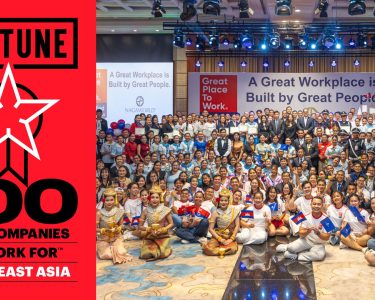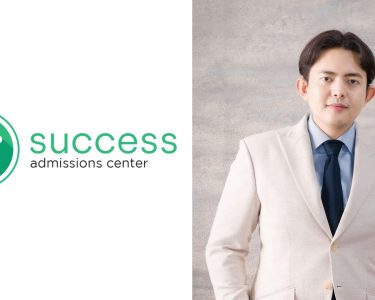Henry Henderson
Communications Intern Henry Henderson sat down with Elettra Melani, Country Director at T3 Architects. Speaking on T3’s journey in Southeast Asia, Elettra shared her vision for sustainable, bioclimatic design and how T3 blends creativity, craftsmanship, and environmental responsibility. Their conversation explored climate-smart solutions for Cambodia, the role of local artisans, and the future of green architecture in the region.
Inspired By The Region’s Rich Heritage and Cultural Diversity
Henry: Could you tell us about T3 Architects’ journey in Southeast Asia and how your vision for sustainable, ethical design has evolved over the years?
Elettra: T3 Architects began its journey in Southeast Asia more than fifteen years ago, inspired by the region’s rich heritage, cultural diversity, and the challenges of its tropical climate. From the very beginning, the goal was to design buildings that live in harmony with their environment and contribute positively to the social and cultural fabric of each place.
Over the years, this vision has evolved into a clear philosophy: do more with less. Minimise waste, cost, and resource consumption without compromising essential functionality, durability, or comfort. It’s about being thoughtful about what is truly necessary, and using local resources in the smartest way possible.
For T3, this is not simply about environmental responsibility; it is about creating architecture with meaning and resilience. The studio draws inspiration from traditional architecture while embracing innovation, works closely with local artisans to develop bespoke details, and seeks out geo-sourced and bio-sourced materials to keep projects grounded in their context. At its heart, the approach is built on respect — for the planet, for culture, and for the people who will inhabit these spaces.
Henry: What does “bioclimatic architecture” mean in practice, and how does it shape the way you approach projects in Cambodia and the region?
Elettra: For T3, bioclimatic architecture is both a science and an act of common sense. It begins with observing the site in detail — understanding the path of the sun, the prevailing winds, the rhythms of rainfall, and the existing vegetation. Every decision is made to harness the climate’s benefits and reduce its challenges.
In Cambodia’s humid tropical monsoon climate, the priorities are clear: protection from the strong sun, natural ventilation for both day and night, rain protection during the heavy monsoons, and the use of insulating materials to help regulate indoor temperatures. These strategies ensure that buildings remain comfortable without heavy reliance on mechanical systems. We also recognise that air-conditioning is necessary for certain buildings, especially in urban contexts, but with a bioclimatic approach, energy consumption can be reduced by half compared to standard buildings in Phnom Penh.
T3 also integrates biophilic design into its work, weaving nature into the everyday experience of a building. Views to greenery, the use of natural materials, and the preservation of existing trees are not decorative gestures but essential components of comfort, well-being, and quality of space. Wherever possible, trees and vegetation should grow from natural soil or be selected from species requiring low water and maintenance, avoiding superficial greenwashing.
Creativity, Craftsmanship, and Environmental Responsibility
Henry: T3’s philosophy blends creativity, craftsmanship, and environmental responsibility. How do you balance these elements while still creating spaces that feel unique and contemporary?
Elettra: In our view, creativity, craftsmanship, and environmental responsibility are inseparable. Creativity allows us to reinterpret traditional knowledge in ways that feel fresh and relevant. Bespoke details bring authenticity and a human touch to every project. Environmental responsibility ensures that our designs will serve people and place for decades to come — durability itself is a strategy for sustainability.
At the core of this balance is elegance: a harmony of proportions, materials, and colours that shape spaces capable of evoking emotion.
Henry: Collaboration with local artists and craftsmen is a hallmark of your work. Can you share a project where these partnerships brought unexpected beauty or innovation?
Elettra: Angsana Siem Reap Resort & Spa was designed by T3 in coordination with Dana Langlois, art director of Java Café. When the project will open to the public, guests will discover one of the largest private collections of contemporary Khmer Art, with tailor-made pieces created for every room and function of the hotel. This collaboration was central to the concept, ensuring that the artistic narrative is woven throughout the guest experience rather than treated as decoration.
T3 Team stays closely connected with the local art scene and actively seeks opportunities to collaborate with artists. Art brings pleasure, original perspectives, and worldly views. Artists are often invited to co-design with us, and this creative dialogue brings real value to all T3 projects.
For Angsana, we combined bioclimatic architecture — naturally ventilated lobbies, open corridors, and shaded rooftops — with a material palette of wood, stone, stucco, and traditional Khmer fabrics. The result is a contemporary resort deeply rooted in Cambodian heritage, where bespoke artistry and thoughtful design come together to create elegance and enduring innovation.
Henry: In your view, what does true “green architecture” involve beyond the common perceptions of solar panels and recycled materials?
Elettra: For us, true green architecture begins with the design itself. Before any technology is added, we focus on orientation, natural ventilation, and responsible material selection — the essential strategies that reduce a building’s energy needs from the start. It also means creating healthy interiors with non-toxic, natural materials, abundant daylight, and a seamless relationship between indoor and outdoor spaces through biophilic design.
We also see refurbishment and adaptive reuse as central to sustainability. By preserving existing structures, we protect heritage, save resources, and reduce the environmental impact of construction. In our view, solar panels and recycled materials should be the complement to these strategies, not the starting point.
Henry: How do you incorporate low-tech, climate-smart solutions into high-end projects without compromising on comfort or aesthetics?
Elettra: We believe low-tech can be the ultimate luxury. Architectural elements such as deep roof overhangs, ventilated roofs, shaded verandas, and carefully positioned openings can be crafted with great precision, delivering comfort and performance while remaining truly elegant. In our high-end projects, we often pair these passive strategies with discreet, efficient mechanical systems for peak conditions. The architecture itself remains the primary provider of comfort, ensuring resilience, beauty, and ease of maintenance.
A perfect example is Namia River Retreat, a sustainable wellness resort we designed on a private island in Hoi An, Vietnam. From the outset, the master plan preserved the natural riverbanks and existing vegetation, with most buildings raised on stilts to protect the soil and allow water flow. The design took strong inspiration from the fishermen’s houses and countryside dwellings around Hoi An, reinterpreting these vernacular forms into organic contemporary architecture that is both resilient and culturally grounded. Among its features are a large bio-filtered natural pool, where aquatic plants and fish help keep the water clean without chemicals, giving it the appearance and atmosphere of a small, living lake, and an aromatic garden that supplies the resort’s herbal treatments, plant-based cuisine, and spa products. Namia shows how climate-smart thinking and refined design can make a project deeply connected to its environment while offering an undeniably high-end experience.
Merge Traditional Cambodian Wisdom
Henry: What do you see as the next frontiers for sustainable tropical architecture in Cambodia?
Elettra: We see two clear paths forward. The first is to merge traditional Cambodian wisdom — from stilt houses to shaded verandas — with modern materials and new technologies, creating architecture that feels both authentic and up-to-date. The second is to give more importance to refurbishment and adaptive reuse, protecting heritage while reducing the environmental impact of development.
Henry: Are there emerging materials, techniques, or cultural trends that you’re excited to explore in your future projects?
Elettra: We are excited by the possibilities offered by geo-sourced and bio-sourced materials, which combine low environmental impact with strong aesthetic and technical performance.
Native to Cambodia and able to reach maturity in just 3–5 years, engineered bamboo offers a high-strength, renewable alternative to concrete for structural applications.
When well protected from rain and direct sun, rammed earth or adobe walls provide excellent indoor comfort in hot climates. Their natural color variation delivers an unmistakable tactile beauty.
By advocating for sustainably harvested hardwood practices, we can create breathable façades that encourage natural ventilation while maintaining durability and reducing reliance on non-renewable cladding materials.
We have used risk husk insulation systems in several projects, including private villas and a dormitory at Hippo Farm, where Vietnamese bulk rice husk mixed with diatomaceous earth was used to insulate the roof. This approach demonstrates the smart reuse of agricultural waste and locally available materials.
Cambodia’s agricultural by-products hold great potential, such as coconut husk for composite panels and recycled materials for non-structural elements. Integrating these resources reduces embodied carbon, supports local economies, and promotes circular design principles.
The renewed appreciation for bespoke fabrication allows us to work closely with local artisans, embedding cultural narratives and fine workmanship into contemporary architecture.
Henry: How does T3 engage with local communities to ensure that projects not only respect but also enhance their cultural and natural environment?
Elettra: We start with observation and dialogue. Spending time on site, meeting with community members, and collaborating with local NGOs or cultural organisations allows us to design in a way that is relevant and respectful.
By sourcing locally and working with local craftsmen, we ensure that economic benefits remain in the community while also contributing to the preservation of skills and traditions. This approach strengthens cultural identity and supports heritage preservation.
Henry: What role do you think architecture can play in preserving heritage while meeting the needs of modern urban life?
Elettra: Architecture can be a bridge between past and present. By integrating traditional forms, materials, and techniques into contemporary projects, we can preserve cultural memory while meeting modern needs.
In urban contexts, refurbishment and adaptive reuse are particularly powerful. They conserve resources, maintain the character of a place, and allow for meaningful innovation. For us, this balance — respecting the past while embracing the future — is essential to creating cities that are vibrant, authentic, and sustainable.





